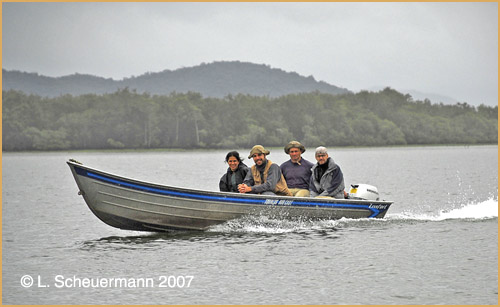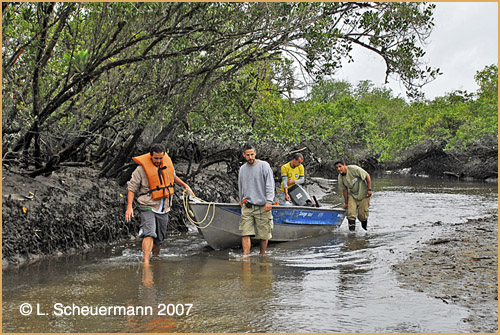Spiders in the SOLOBIOMA Project
Because biodiversity surveys in complex ecosystems like rainforests need big effort, one should concentrate on a few selected and representative faunistic taxa. Invertebrates and especially the arthropods are an adequate group for such studies (Bihn 2007, New 1999, Churchill 1997) because they generally exist in highly diverse communities and have a big impact as predators, herbivores and decomposers on ecosystem processes. We choose the spiders as a group for our part of the diversity evaluation of the SOLOBIOMA project.

Boat excursion to the study sites.
Why include spiders?
- Spiders represent a uniform functional group in the soil arthropod community – they are predators without exception and as such they occupy a key position in the community.
- They appear in high abundance and diversity, so that one can give conclusions about the state of diversity in general.
- Because of their high diversity they also demonstrate various strategies to find their prey and thus show a high rate of interaction with their environment. A change in the spider community can reflect environmental changes.
- They are relatively well described and they are easy to sample, but on the other hand little is known about the diversity and the ecology of forest dwelling spiders in the Mata Atlântica.
- Churchill (1997) and Martin (1999) clearly showed that spiders can be potential bioindicators in conservation questions.
Project SOLOBIOMA General Question: Can the secondary forests at a certain age serve as a surrogate habitat for different soilfauna taxa in place of the largely destroyed mature or old growth forests?
For the spider survey this means:
- How many and which spider species inhabit the old growth and the secondary forests in different regeneration stages?
- Which part of the spider species richness of the old growth can the different stages of secondary forests host?
- Will the spider richness regenerate to the original state and if so: how long does it take to regenerate (keyword: resilience)?

Stranded in the mangroves (Serra do Itaqui).